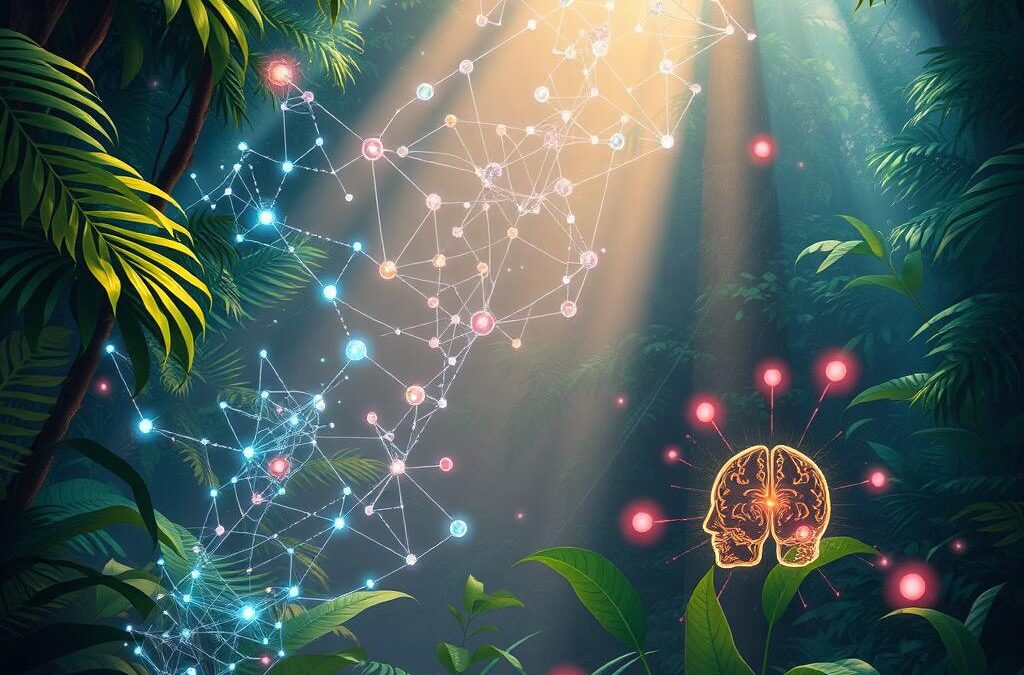The exploration of ayahuasca and its effects spans various fields, from neuroscience to psychology and anthropology. This analysis focuses on how ayahuasca may influence neuroplasticity, creativity, and elevated states of consciousness, as well as its implications for mental health and personal development.
Ayahuasca and Its Composition
Chemical Composition
Banisteriopsis caapi: This plant contains monoamine oxidase inhibitors (MAOIs), which are crucial for allowing DMT to be absorbed by the body. Without MAOIs, DMT would quickly decompose and have no psychoactive effect.
Psychotria viridis: This plant is the source of DMT, a potent hallucinogen that induces deep and transformative experiences. The combination of these two plants makes ayahuasca unique and powerful.
Cultural Context
Ayahuasca holds deep cultural significance in many indigenous Amazonian communities. It is used in ceremonies for spiritual and physical healing, and its use should be approached with respect for these traditions. Understanding the cultural context is essential to avoid exploitation and distortion of ayahuasca’s use in modern contexts.
Synaptic Connection and Neuroplasticity
Neural Mechanisms
Increase in BDNF:
Brain-derived neurotrophic factor (BDNF) is vital for neuron survival and differentiation. Ayahuasca may increase BDNF levels, promoting neurogenesis and improving synaptic plasticity, which facilitates learning and memory.
Changes in Brain Connectivity: Neuroimaging studies have shown that psychedelics, including ayahuasca, can increase connectivity between brain regions that typically do not communicate effectively. This may allow for greater cognitive flexibility and an enhanced ability to make creative connections.
Implications for Psychotherapy
Ayahuasca’s potential to promote neuroplasticity suggests it could be useful in treating mental disorders such as depression, post-traumatic stress disorder (PTSD), and anxiety. Its use in therapeutic settings may facilitate emotional exploration and trauma resolution.
Impact on Intelligence Quotient
Creativity and Problem Solving
Creative Thinking: Experiences with ayahuasca may open new avenues of thought, leading to creative solutions to problems. This relates to divergent thinking, a key component of intelligence, even though it is not directly measured in IQ tests.
Self-Knowledge and Personal Development
Reflection and Personal Growth:
The introspection facilitated by ayahuasca may allow individuals to identify and challenge limiting thought patterns, promoting greater self-awareness and improved interpersonal skills.
Elevated States of Consciousness
Mystical Experiences
Personal Transformation:
The mystical experiences often occurring during ayahuasca use can generate significant changes in a person’s life perspective, fostering a sense of connection with others and the universe, enhancing empathy and social skills.
Alterations in Perception
Perception of Time:
The ability to experience time in a non-linear fashion can facilitate revisiting and reinterpreting past experiences, which can be therapeutic and contribute to emotional healing.
Scientific Research and Limitations
Controlled Studies and Results
Current research shows growing interest in the therapeutic benefits of ayahuasca, but more controlled and randomized studies are needed to validate preliminary findings and establish safe and effective treatment protocols.
Diverse Methodologies
The heterogeneity of studied populations and the variety of methodological approaches make comparing results difficult, while the subjectivity of psychedelic experiences poses challenges in measuring their effects.
Ethical and Social Considerations
Cultural Use and Respect
Respect for traditions is essential when approaching the use of ayahuasca, focusing on the cultural practices of indigenous communities. Commercialization and spiritual tourism can distort the meaning of ayahuasca.
Potential Risks
Not all individuals respond positively to ayahuasca; side effects can include anxiety, confusion, and exacerbation of pre-existing psychological disorders. Preparation and context are crucial to minimizing risks.
Conclusions and Future Directions
Ayahuasca represents an intriguing intersection of neuroscience, psychology, and spirituality. Its effects on neuroplasticity, creativity, and self-knowledge suggest that its use could have beneficial applications in mental health and personal development.
Recommendations for Future Research
Clinical Trials:
Larger clinical trials are essential to establish safe and effective protocols for using ayahuasca in therapeutic contexts.
Interdisciplinary Research:
Encouraging collaboration among neuroscience, psychology, anthropology, and medicine can enrich the understanding of ayahuasca’s effects.
Education and Awareness:
Increasing education about the responsible use and cultural significance of ayahuasca can help prevent exploitation and promote a more conscious approach to its use.
This analysis highlights both the promises and challenges associated with ayahuasca use, emphasizing the importance of an informed and respectful approach. Ongoing research is vital to fully understand its potential and implications for mental health and personal development.
Ayahuasca Peru Best Ayahuasca Retreats Peru Ayahuasca Iquitos Shamanic School Peru Flower of life Ayahuasca Peru Ayahuasca Healing Center
We would be delighted to welcome you to our sanctuary, where experienced shamans and facilitators will guide you through sacred ceremonies and rituals with reus at the Flower of Life Ayahuasca Healing Center for an unforgettable experience in the heart of Peru’s Amazonian Rainforest. Embrace the opportunity to reconnect with yourself, nature, and the sacred traditions of the jungle, and embark on a journey of self-discovery and empowerment. We look forward to walking this path with you and supporting you on your quest for healing and transformation.
www.floweroflifeperu.com

